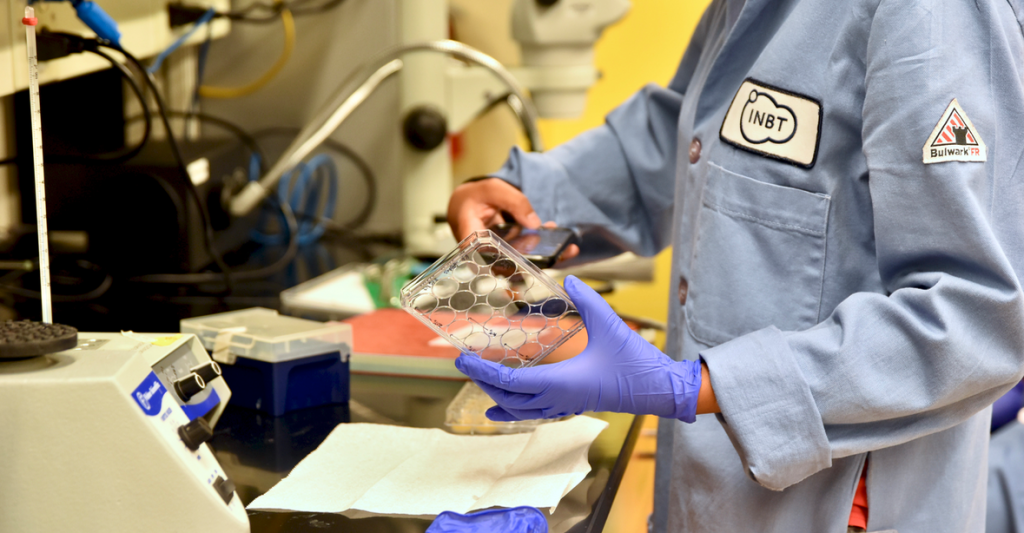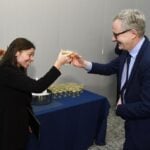Bioengineering Innovation Aims to Heal Painful Crohn’s Condition

Crohn’s Disease, an inflammatory bowel disease, affects some 790,000 people in the United States each year. One of the many complications of the disease is perianal fistulas: an abnormal duct that develops in the skin around the anus and the inside of the rectum, causing serious complications such as infection and fecal leakage.
Hussein Elfayoumy, a senior materials science and engineering student, has designed a gelatin hyaluronic acid fiber-based (GelHA) plug to treat the condition. He will present his research during the Whiting School of Engineering’s annual Design Day on May 1.
“My goal is to create a novel plug that closes the tract by promoting soft tissue repair,” says Elfayoumy.
He posits that his approach, which surgeons would place inside the rectum, would be more effective than current treatments. Existing remedies fail to close the fistula and require additional operations.
Working with Hai-Quan Mao, professor and director of the Institute of NanoBio Technology, Elfayoumy devised a design that comprises three liquids: Hyaluronic acid, gelatin B, and adipose-derived stem cells.
He chose Hyaluronic acid, a common ingredient in skin creams, because it forms a hydrogel, allowing the plug to fit inside the tract without discomfort or risk of breakage. Gelatin B, derived from cattle skin, gives the hydrogel the strength and rigidity to prevent the plug from escaping the tract. The third component, adipose-derived stem cells, encourages the formation of fat cells in blood vessels, allowing new tissue to grow and eventually absorb the plug, healing the fistula altogether, he said.
“To create this plug, I had to make the gelatin B into a nanofiber first,” says Elfayoumy. “I did this through electro spinning — a technique that uses an electrical field to produce thin polymer fibers from liquids.”
To do this, he first dissolved gelatin B powder in acetic acid and water. Then, he inserted it into a syringe connected to a voltage emitter, so the solution exits the syringe in strands instead of droplets. The bands of the gelatin B solution land on a horizontal rod, which is spinning at about 100 rotations per minute. The minuscule strands that extrude from the syringe form together on the rod, covering it with equal amounts of fiber. After the nanofiber is made, it can be crosslinked with hyaluronic acid, producing a chemical reaction that bonds the two substances together into one uniform structure.
“My primary role was finding the optimal amount of solution to electro-spin, so the plug is neither too stiff nor too smooth,” says Elfayoumy.
Not only did his design project teach Elfayoumy about the precision of electro-spinning and materials in biomedicine, but it also helped him explore a new area in medicine.
“When I started in pre-med, I had no idea what I wanted to do with it,” says Elfayoumy. “As I became interested in studying perianal fistulas, I spoke with Florin Selaru, the director of the Meyerhoff Inflammatory Bowel Disease Center at Johns Hopkins School of Medicine. He guided me towards gastroenterology and clinical applications of this project.”
Researchers in the Mao Lab will continue working on this project in the future.
Story by Conner Allen in the Department of Materials Science and Engineering.
Latest Posts
-
 Cellular building blocks may enable new understanding of the body’s “machinery”
December 19, 2025
Cellular building blocks may enable new understanding of the body’s “machinery”
December 19, 2025
-
 Biomedical Engineer Jamie Spangler Receives President’s Frontier Award
December 15, 2025
Biomedical Engineer Jamie Spangler Receives President’s Frontier Award
December 15, 2025
-
 Johns Hopkins Postdoc Named in Forbes `30 Under 30′ List
December 8, 2025
Johns Hopkins Postdoc Named in Forbes `30 Under 30′ List
December 8, 2025


